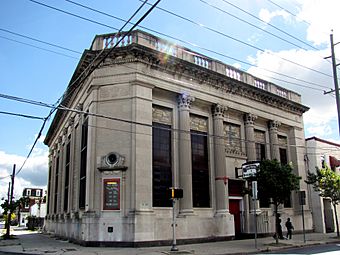South Camden Trust Company facts for kids
|
South Camden Trust Company
|
|
|
U.S. Historic district
Contributing property |
|

South Camden Trust Company
|
|
| Location | Broadway at Ferry Street Camden, New Jersey |
|---|---|
| Architect | Lackey and Hettel |
| NRHP reference No. | 90001255 |
Quick facts for kids Significant dates |
|
| Added to NRHP | August 24, 1990 |
The South Camden Trust Company building is a special historic place in Camden, New Jersey. It is located in the Waterfront South area. This building was added to both the state and national lists of historic places in 1990. It was built in the 1920s and has been used as a church for a long time.
Contents
The South Camden Trust Company Building
This building started its life as a bank. It was built to be the home of the South Camden Trust Company. Over the years, its purpose changed. Today, it serves as a church, continuing to be an important part of the community.
A Look at Its History
The South Camden Trust Company building was completed in 1926. This was a time of growth and change in many American cities. Banks like this one were important places. They helped people save money and businesses grow. After its time as a bank, the building found a new purpose. It became a church, which it remains to this day.
Its Design and Purpose
The building was designed by architects Lackey and Hettel. They created it in the Neoclassical style. This style takes inspiration from ancient Greek and Roman buildings. Think of grand columns and strong, balanced shapes. This design made the bank look important and trustworthy. It was meant to show strength and stability to its customers.
Becoming a Historic Landmark
The South Camden Trust Company building is recognized for its history. It was added to the New Jersey Register of Historic Places on January 1, 1990. Later that year, on August 24, 1990, it was also listed on the National Register of Historic Places. These lists are like special honors. They recognize buildings, sites, and objects that are important to the history of a state or the entire country. Being on these lists helps protect the building. It ensures that its historical value is remembered and preserved for future generations.


